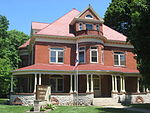Chillicothe Correctional Institution
Chillicothe Correction Institution, or CCI, is a state-run medium security prison on the west bank of the Scioto River just outside Chillicothe, Ohio. It is located adjacent to Ross Correctional Institution and Hopewell Culture National Historical Park. The prison is a former military camp, named for Civil War general William Tecumseh Sherman. It later became a federal penitentiary and has housed several high-profile prisoners including Charles Manson in 1952, bootlegger and future NASCAR driver Junior Johnson, and serial killer Anthony Sowell. Country music legend Johnny Paycheck also served a 22-month stint in CCI for shooting a man in a Hillsboro bar. During Paycheck's time there, his friend and fellow musician Merle Haggard performed for the inmates.
Excerpt from the Wikipedia article Chillicothe Correctional Institution (License: CC BY-SA 3.0, Authors).Chillicothe Correctional Institution
SR 104, Chillicothe
Geographical coordinates (GPS) Address Phone number Website Nearby Places Show on map
Geographical coordinates (GPS)
| Latitude | Longitude |
|---|---|
| N 39.374444444444 ° | E -83.011388888889 ° |
Address
Ross Correctional Facility
SR 104 16149
45601 Chillicothe
Ohio, United States
Open on Google Maps










